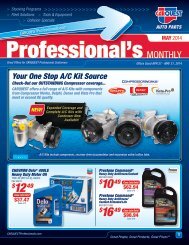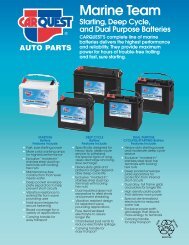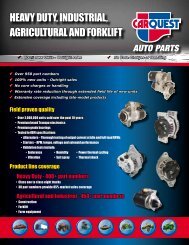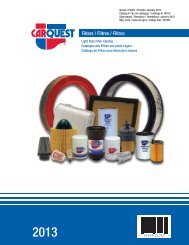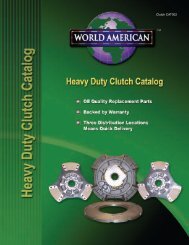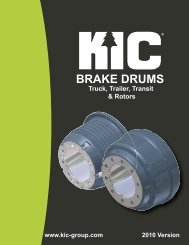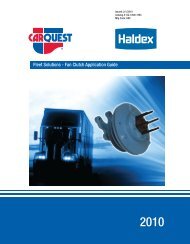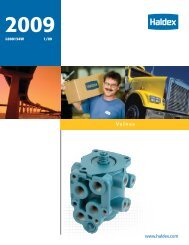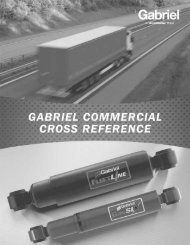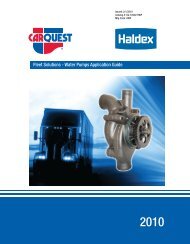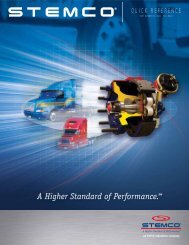Steering Gears Application Guide - CARQUEST Auto Parts
Steering Gears Application Guide - CARQUEST Auto Parts
Steering Gears Application Guide - CARQUEST Auto Parts
- No tags were found...
You also want an ePaper? Increase the reach of your titles
YUMPU automatically turns print PDFs into web optimized ePapers that Google loves.
16−POWER STEERING GEARSHydraulic Supply DiagnosisThe Sheppard Integral Power <strong>Steering</strong> Gear is dependent upon adequate supplies of oil pressure and volume of oil flow toenable the steering gear to operate as designed. Oil pressure reacting on a piston creates the force to cause the piston tomove and assist steering effort.As the piston moves it is displaced in the cylinder bore by a volumn of oil under pressure. How fast the piston can bedisplaced is dependent upon adequate oil flow and volume.Oil pressure and oil flow requirements are engineering considerations that are established during the design of a totalpower steering installation. When diagnosing power steering problems you must be able to determine that oil pressure andoil flow meet design specifications. Pressure and flow specifications vary considerably and the vehicle manufacturer'srecommendations must be followed carefully at all times.Back pressure and operating temperature are two additional factors that must be considered during the diagnosis of powersteering problems. High back pressures will restrict the movement of the piston in the power steering gear and this backpressure must be overcome before steering power is available. Back pressure is caused by restrictions to oil flow. Aclogged oil filter, undersized fittings and lines, pinched lines and high flow rates are possible causes of back pressure.High system oil temperatures reduce the overall efficiency of the steering pump and the steering gear. High temperaturesare caused by restriction to flow or inadequate system oil capacity to allow for heat dissipation during normal operation. Asupply pump which constantly operates at maximum relief pressure will also generate more heat than can be dissipated.Various types of pressure gauges and flow meters are available and can be used to diagnose power steering problems. Apressure gauge which reads at least 3000 PSI and a flow meter with a capacity to 10 GPM are used to check pressuresand oil flow. A shutoff valve downstream from the pressure gauge makes it possible to isolate the steering pump from thesteering gear and by closing the valve, maximum pump relief pressure can be read.Using the equipment available to you, proceed with your evaluation of the hydraulic supply system.1. Make necessary gauge/meter connections.2. Start engine & check system oil level assuring that oil flow is in proper direction through flow meter.3. Place thermometer in reservoir.4. Run the engine at correct idle speed and steer from lock−to−lock several times to allow system to warmup. (140 to 160F)5. Pump Maximum Pressure ReliefWith the engine running at specified idle speed, slowly turn the shutoff valve until closed and read thepressure at which the pressure relief valve opens. (Open the shutoff valve as quickly as possible to avoidheat build−up or possible damage to the steering pump.) This pressure reading should equal themaximum pump pressure specified by the manufacturer of your chassis. Check your specifications.16 − 40



